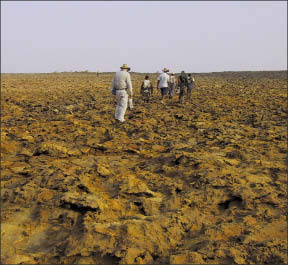Despite lingering concerns in North America and Europe over a slower-than-expected economic recovery, there appears to be little worry left in Ethiopia’s potash-rich Danakil Depression.
With the price of potash again on the rise, interest in the past-producing area – a desert-like valley with some of the hottest recorded temperatures on earth – is also heating up. Danakil’s proponents have started to compare the evaporate basin with those found in Saskatchewan and Russia, which together account for roughly 50% of global potash production.
Toronto-based Ethiopian Potash (FED-V) began trading on the TSX Venture Exchange in March, saying it controls more than half of the Danakil basin fairway. The company acquired most of the land in a complicated reverse takeover of Panorama Resources (a former TSX-V shell) and G&B Central African Resources, a private British Virgin Islands (BVI) company controlled mainly by British promoter George Roach and South African geologist Bruce Cumming.
While the deal gives Ethiopian Potash immediate access to a prospective potash district, it also leaves plenty of cheap escrow shares in the hands of insiders (with 15% blocks of the shares becoming free trading every six months.)
Through ZRH Nominees Ltd., a BVI company, and Coc’roach Ltd., an Isle of Man company, chairman Roach controls roughly 19.6 million escrow shares issued at a nominal price of 20¢ each. He was previously the managing director of African operations for UraMin, a uranium company bought by the Areva Group for US$2.5 billion in 2007. He also has an interest in a sugar plantation under development in the Central African Republic and a spice trading operation in South Africa.
Cumming, the company’s new vice-president of exploration, controls 12.85 million escrow shares through a private Isle of Man company. He spent most of his career in Africa with Falconbridge before eventually becoming a consultant.
Acting as middlemen between Panorama and G&B were the DesLauriers brothers, David and Michael, who helped take Ethiopian Potash public. Together, they control 18.6 million escrow shares through two private Uruguyan companies. Their father, 72-year-old Toronto broker Paul DesLauriers, is now a director of Ethiopian Potash and acts as their representative. Lastly, Hussein Jamal and Mohammed Said, two Ethiopian businessmen connected with the acquisition but no longer with Ethiopian Potash, control 9.38 million shares each.
Escrow shares notwithstanding, Ethiopian Potash has become well positioned to explore its new properties and add value for shareholders. It raised $13 million before listing and has about $11 million left, after paying for legal fees, two drill rigs and setting up an exploration camp. The company expects to begin a 15,000-metre drill program on its Ethiopian properties in mid- to late April, focusing on proving up historical reserves and exploring other shallow targets.
The properties also seem to be in the right area. They are surrounded on three sides by BHP Billiton (BHP-N, BLT-L), Allana Potash (AAA-V) and NGEx Resources (NGQ-T), a Lukas Lundin company.
BHP and Allana were the first to arrive, however, with Allana acquiring most of the historic Musley deposit from three private vendors. According to a technical report compiled by Ercosplan Geotechnik (based on exploration completed in the 1960s by an American company, Ralph Parsons Co.), the Musley deposit has a non-compliant historical resource of 105 million tonnes grading 20.8% KCl.
Ethiopian Potash says the northern part of Musley extends onto its Danakil property, meaning some of the historical resource is now attributable to it, and not Allana. Based on six drill holes completed by Parsons, Ercosplan has calculated a non-compliant, inferred resource for three separate potash intervals within the southwest corner of the Danakil property: a first zone of 28 million tonnes grading 29% KCl in sylvinite; a second zone of five million tonnes at 22% KCl in carnallitite and/or polyhalite; and a third zone of 95 million tonnes grading 18% KCl in kainitite.
There are no other reliable data for other parts of the Danakil property or Ethiopian Potash’s Bada property to the north.
Allana has enjoyed considerable market success over the past year exploring the Musley deposit and other targets while testing the unexplored limits of its concessions to the south. (According to Ercosplan, the Danakil Depression structure widens to the south – away from Ethiopian Potash’s concessions). The structure is about 10 km wide in the north and up to 70 km wide in the south, however the deepest section is in the north, with elevations as low as 128 metres below
sea level.
From a plate tectonic perspective, the Danakil Depression is the most northern part of the Afar Triangle, which joins the East African graben system with the Red Sea and the Gulf of Aden. It is a typical graben structure orientated northwest-southeast, with bedded halite separating the different potash intervals along with occasional seams of anhydrite.


Be the first to comment on "Ethiopian Potash upbeat about the Danakil Depression"